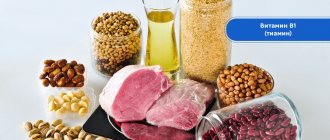B vitamins are low-molecular-weight food components necessary for human life. According to their physicochemical properties, vitamins of this group are classified as water-soluble.
In modern medical practice, both individual vitamins from this group and complexes are often recommended for use in various pathologies. The widespread use of these substances is due to the fact that they perform essential functions in our body, directly or indirectly participating in the metabolism of various substances.
Vitamin B1 (thiamine)
The vitamin thiamine and its active derivative, thiamine pyrophosphate, is an essential participant in the metabolism of carbohydrates in our body, facilitating the conversion of glucose into energy. For normal functioning of the body, an adult needs to receive 2-3 mg per day.
Natural sources of thiamine are legumes (peas, beans, lentils), wholemeal flour, liver, kidneys, brain, yeast.
With its deficiency, first of all, disorders occur on the part of the system most dependent on the absorption of carbohydrates - the nervous system. In addition, products of incomplete oxidation of glucose, circulating in the blood, cause negative reactions from other organs and tissues.
Hypovitaminosis of thiamine is manifested by weakness, fatigue, multiple polyneuritis - pain and impaired sensitivity in the limbs and back, as well as pain in the heart. With an extreme degree of vitamin B1 deficiency, a pathological condition occurs - beriberi, manifested by extremely pronounced symptoms of damage to all organs and systems.
Vitamin B7 (biotin, vitamin H)
The name “biotin” comes from the Greek “bios” (“life”). Biotin is necessary to maintain normal blood glucose levels, for gluconeogenesis, metabolism of carbohydrates, fatty acids, and proteins.
Vitamin B7: Deficiency Symptoms
Without Vitamin B7, skin, nails and hair cannot be in normal condition. Its deficiency can be recognized by many signs. The first to appear due to dehydration and damage to the lipid layer is dry and itchy skin. This creates a perfect environment for infections and harmful bacteria. As a result, seborrheic dermatitis and redness may appear. Hair becomes thin and greasy, nails become thin and rough, and alopecia develops. On top of everything else, loss of appetite and nausea, chronic fatigue, and headaches are added.
Vitamin B7: daily value
Reference values: 0.025 - 5.647 nmol/l, daily requirement - 50 mcg.
Vitamin B7: what foods contain it?
Biotin is found in egg yolk, soybeans, oatmeal, peas, milk powder, rice, wheat, barley, and chicken.
shutterstock.com
Vitamin B2 (riboflavin)
Riboflavin is a precursor of two enzymes, FAD and FMN, which are essential for tissue respiration. These substances are intermediate participants in the transfer of electrons in the respiratory chain and other energy reactions. The substance itself has a bright yellow color and is sometimes used as a dye in powders for making broth. The daily requirement is 2-4 mg. With a deficiency, inflammation of the skin and mucous membranes, seizures in the corners of the mouth, and general muscle weakness occur.
Natural sources are egg yolks, wholemeal flour and baked goods, and yeast.
Vitamin PP (nicotinamide)
Nicotinamide is a precursor to two enzymes - NAD and NADP, which actively participate in redox reactions by transferring electrons. A deficiency of this substance is called pellagra.
The pathological condition is manifested by symmetrical dermatitis on open areas of the skin, disruption of the gastrointestinal tract, in particular diarrhea, as well as weakness, fatigue, decreased memory and attention.
Natural sources of this substance are cereals, meat, potatoes, liver, and kidneys. The daily requirement is approximately 15-25 mg.
Vitamin B6 (pyridoxine)
Pyridoxine is involved in the metabolic processes of decarboxylation and transamination of amino acids, plays a critical role in ensuring the functioning of the central nervous system, ensuring the exchange of dopamine, norepinephrine, serotonin, and GABA. Plays a role in the synthesis of hemoglobin.
Most often, a deficiency of this substance develops in people who abuse alcohol - due to increased costs and impaired absorption of it from food. In the body of a healthy person, a significant contribution to meeting the need for pyridoxine is made by the synthesis of pyridoxine by intestinal microflora.
Natural sources of vitamin B6 are legumes, nuts, potatoes, cabbage, tomatoes, avocados, and eggs.
Lack of pyridoxine is manifested by symptoms of damage to the nervous system, in particular sensory disturbances in the extremities, insomnia, anxiety, as well as weakness, increased fatigue, pale skin, congestion in the corners of the mouth, and anemia.
To avoid such negative phenomena, the body should receive a total of about 2 mg of pyridoxine, including the one synthesized by the microflora.
B vitamins: where are they found and what do they affect?
Despite their diversity, all B vitamins have one thing in common: they help improve metabolism in the human body and normalize the functioning of the immune and nervous systems.
All these vitamins are water-soluble and are quickly eliminated from the body without accumulating in it. This means that it is necessary to replenish their reserves by taking special vitamin complexes and not forgetting about foods rich in these substances.
An important fact: doctors claim that taking B vitamins in combination has a much more noticeable effect than taking any one “variety” of B vitamins.
Therefore, let's figure out what we should eat in order to reinforce the body with useful substances, which B vitamins produce and what is remarkable about each of them.
B1 (thiamine) - energy vitamin
Benefit: Helps convert fats, proteins and carbohydrates into energy. Strengthens the nervous system and improves thinking abilities.
Contains: buckwheat and oatmeal, cereal shells, wholemeal bread, green peas, asparagus, pine nuts.
B2 (riboflavin) - beauty vitamin
Benefit: takes part in all metabolic processes of the body. Improves the condition of the skin, mucous membranes, nails and hair (hence the name “beauty vitamin”), is good for vision, and promotes the production of hemoglobin.
Contains: meat, offal (liver, kidneys), chicken eggs, mushrooms, cabbage (white cabbage, broccoli, etc.), pasta, white bread, refined rice, buckwheat, cottage cheese.
B3 (nicotinic acid, vitamin PP) - vitamin of synthesis and metabolism
Benefits: helps synthesize fats and proteins, promotes the production of energy from food, reduces the level of “bad cholesterol” in the blood. In addition, vitamin B3 helps normalize venous and blood pressure and stimulates the functioning of the cardiovascular system.
Contains: fish, milk, egg yolk, nuts, liver, kidneys, yeast, buckwheat, green vegetables, legumes, meat, potatoes.
B4 (choline) - a vitamin responsible for blood sugar
Benefits: this vitamin is important for the normal functioning of the nervous system and is useful for stress. In addition to its calming effect, B4 will help your thinking abilities. But most importantly, this vitamin regulates blood sugar levels. It also normalizes fat metabolism, which has a positive effect on your weight.
Contains: offal (kidneys, liver), egg yolk, dairy products (cheese, cottage cheese), cabbage, spinach, legumes, various unrefined vegetable oils, meat, fish.
B5 (pantothenic acid) - healing vitamin
Benefits: helps wounds heal faster, promotes the synthesis of antibodies, fatty acids, hemoglobin, and participates in the processes of cellular energy production.
Contains: poultry, fish roe, heart, liver, kidneys, yolk, buckwheat and oatmeal, green leafy vegetables, peas, hazelnuts, yeast.
B6 (pyridoxine) - vitamin for the nervous system
Benefit: participates in the regulation of the activity of the nervous system, the production of red blood cells, the synthesis of hemoglobin and antibodies, and promotes normal carbohydrate metabolism.
Contains: dairy products, fish, offal (kidneys, heart, liver), legumes, cereals, carrots, cabbage, spinach, potatoes, nuts (walnuts, hazelnuts), tomatoes, oranges, strawberries, yeast, wheat bran.
B7 (biotin, vitamin H, coenzyme R) - vitamin for beautiful skin
Benefits: restores health and beauty to skin and hair, is beneficial for bone and nerve tissue, regulates the activity of sweat glands.
Contains: yolk, liver, kidneys, yeast, tomatoes, soybeans, peanuts and other legumes, spinach, mushrooms, vegetables (cabbage, carrots, potatoes), dairy and meat products, fish.
B8 (inositol) – slimming vitamin
Benefits: helps reduce weight, participates in the regulation of cholesterol levels, protects against atherosclerosis, and is good for the brain.
Where it is contained: yeast, bran and wheat germ, offal (brain, heart), bread, green peas, oranges, raisins, citrus fruits, carrots.
B9 (folic acid, vitamin M) - women's vitamin
Benefit: indispensable for pregnant women, as it helps the fetus to develop properly. Children also need to take folic acid during their growth period. Vitamin B9 contributes to an easy pregnancy, as well as normalization of the emotional background before and after childbirth.
Contains: legumes, citrus fruits, yeast, liver, green leafy vegetables, nuts, yolk, fish, wholemeal flour, fruits (bananas, apricots, melon, oranges).
B12 (cobalamin) - anti-anemia vitamin
Benefit: participates in the processes of growth and activity of the nervous system, promotes the formation of red blood cells. Prevents the development of anemia.
Where it is contained: products of animal origin: meat, fish, poultry, offal, eggs, seafood.
B13 (orotic acid) - a vitamin for pregnant women
Benefits: promotes fetal development, has a beneficial effect on reproductive health, normalizes liver function.
Where it is contained: root vegetables, whey, cottage cheese, yeast, liver.
B17 (laetral) - anti-pain vitamin
Benefits: helps cope with pain, slows down the aging process, improves metabolic processes. Useful in the fight against cancer.
Where it is contained: seeds of fruits and berries (apples, plums, apricots, peaches, cherries).
Vitamin B9 (folic acid)
Folic acid plays a huge role in the development of the circulatory and nervous systems. Regular intake of this vitamin is most important for children and pregnant women. Sufficient intake of vitamin B9 helps to avoid anemia, and for pregnant women to reduce the risk of spontaneous abortion and prevent defects in the development of the nervous system in the unborn child.
Found naturally in green vegetables, cereals, and liver.
The daily requirement depends on age and is 200 mcg for an adult, and 400 mcg for pregnant women.
Secrets of appearance
“Vitamin B” is the name given by scientists at the beginning of the 20th century to a newly discovered miracle substance that prevented many diseases (for example, beriberi, scurvy, pellagra). But science developed, methods for obtaining individual compounds were improved, and new ways of purifying them from impurities were discovered. Gradually we found out that there are many vitamins and each has its own role in the body. Thus, vitamins A, C and E became known. It was determined that vitamin B consists of at least two others. The factor that prevents beriberi disease is called B1. And the substance that fought pellagra became known as vitamin B3. The index “3” was given to him because by the time it was possible to isolate it, vitamin B2 already existed.
Over time, chemists have established the exact structure of each vitamin. As a result, it became clear that some of the substances called vitamins are not vitamins. For example, vitamin B11 completely matches the formula of the amino acid L-carnitine. It also turned out that some vitamins are the same substance, simultaneously discovered in different countries and therefore have two names. Among such pairs are vitamin B7 and vitamin H (biotin), vitamin B9 and vitamin BC (folic acid).
Vitamin B12 (cyanocobalamin)
The main role of this substance is to directly participate in the synthesis of hemoglobin, which is why it is also called the external Castle factor.
For the absorption of this substance, it is important not only its consumption in food, but also adequate functioning of the gastrointestinal tract, since with hypoacid gastritis or after gastrectomy, B12 does not bind to the intrinsic factor of Castle and is not absorbed.
As a result of its deficiency, anemia develops, for the treatment of which periodic administration of it intramuscularly is used. In addition to the hematopoietic system, the nervous system also suffers; dystrophy of spinal cord neurons develops, which over time leads to impaired movement and sensitivity in the lower extremities. Such a complication is rare nowadays, but before the advent of vitamin B12 preparations it was a natural outcome of its constant deficiency.
The main sources are products in which this vitamin accumulates during the life of animals, for example, liver and kidneys.
Normally, a person should receive an average of 5 to 7 mcg of cyanocobalamin per day.
Considering that all B vitamins are water-soluble, an overdose when eating foods rich in them is not observed. If they enter the body in excess, they are quickly eliminated by the kidneys.
Many beverage and breakfast cereal manufacturers claim that their products are fortified with B vitamins.
What vitamins cannot be combined
Good compatibility of vitamins can provide the body’s daily needs. If you take substances that interact poorly with each other, at best there will be no effect from such treatment, and at worst, the risk of developing side effects will increase.
Before you start taking vitamins, you should familiarize yourself with their compatibility with each other.
Poor compatibility can disrupt the absorption of one or more components.
- Vitamin D cannot be combined with A, since they neutralize each other’s effects;
- Vitamin B2 leads to the oxidation of B1;
- Vitamin B1, if combined with B12, can cause an allergic reaction;
- Vitamin D is not absorbed if taken with vitamin E;
- Vitamin B12 eliminates the properties of C and PP;
- Vitamins A and D neutralize each other;
- Vitamins E and D must be taken separately, since the first component is poorly absorbed under the influence of another substance;
- Oxidation of vitamin B1 occurs under the influence of vitamin B2.
Many multivitamins contain substances that interact poorly with each other, but their composition is selected in such a way that it does not have a negative effect on the human body.








